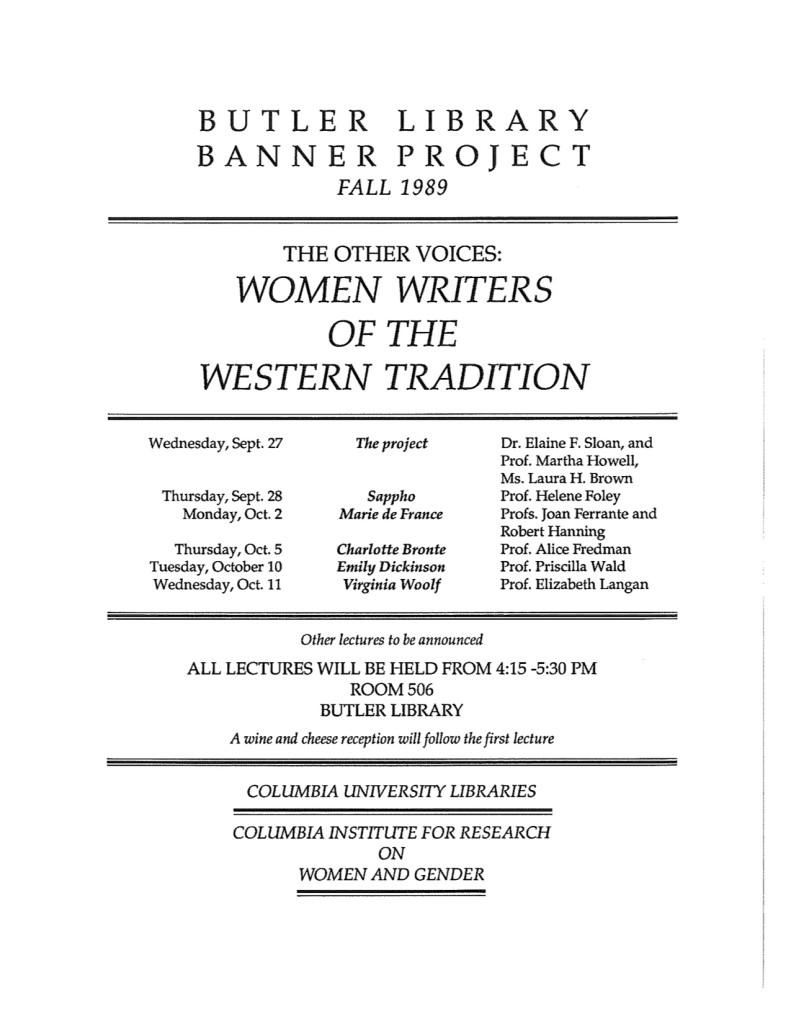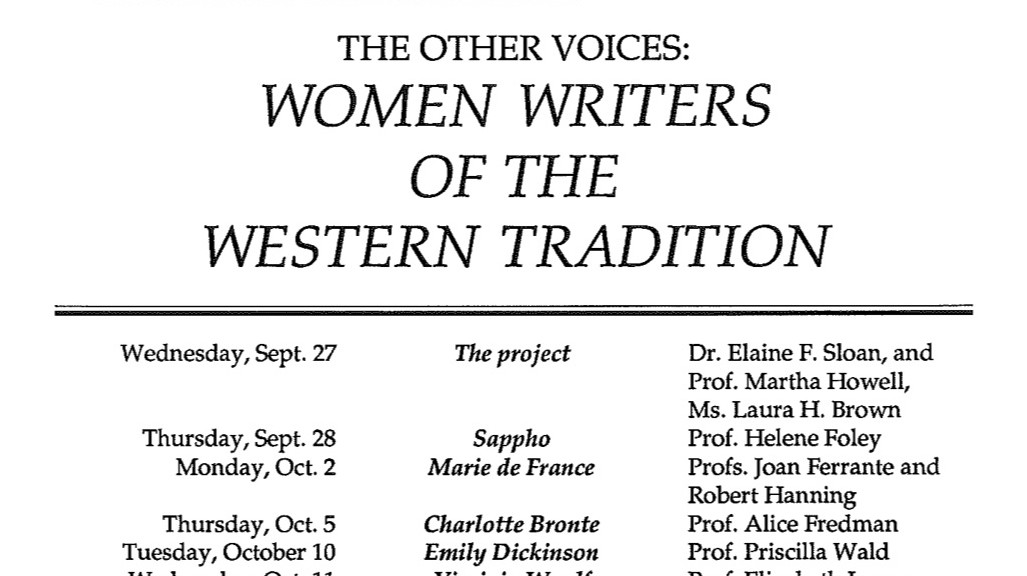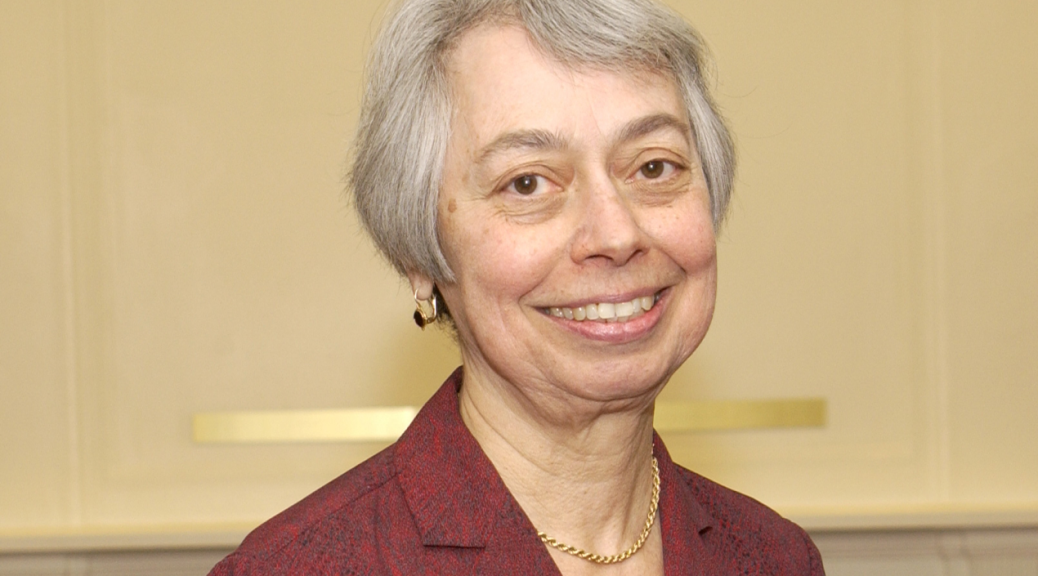
Category Archives: Joan Ferrante
“It was a place where women could come together…”
JOAN FERRANTE
Professor Emerita of English and Comparative Literature
One of the things I liked about it when I first came was that it’s a centrifugal place. People do not live in each other’s pockets the way they do at so many universities. They tend to want to have lives in New York, not in Columbia. Building community in that sense is not easy. We could get people together around political issues, and the University Seminars did, to some extent, get people together around intellectual issues, but a lot of the people who make up those seminars come from other parts of the city and other universities. They come partly for the intellectual exchange and partly, it has to be admitted, because they get library privileges at Columbia.
I think you’re going to be hard-pressed to find groups—the center, yes, because the center was—that’s one of the reasons I think Carol [Carolyn Heilbrun] wanted to set it up. It was a place where women could come. There were lectures. I’ve gone to lectures even since I’ve retired, interesting things that were all over the map, but of great interest, and they always got a small group of people together—students, graduate students, junior faculty, and some senior faculty—outside lectures and stuff, and those were interesting, and that was a community. They met over even undergraduate papers in women’s studies once women’s studies got through as a possible major, but they always had them at Barnard, and they had them at General Studies. So there were women, and they would come together to celebrate the theses that were done there, and the MA essays and that sort of thing. That became a community, but that’s after the establishment of the center, not before.
“We needed some place that would be a center for women’s issues…”
JOAN FERRANTE
Professor Emerita of English and Comparative Literature
People came from the Medical School, and Public Health, and wherever there were women—Business, there was one. In Journalism, there was one. Law School—wherever there were women. They came, and they participated, and they were interested, and they were helpful. They all had had problems. There was no nonsense about, “I made it. Why can’t others?” They all recognized the problems.
Essentially, as I recall, we threw them open to people and said, “Look, we’re trying to set up this committee. We’d like people to work on it. We’d like to know what are the issues you think are important for women that we should work for in the university—things like childcare, obviously, maternity leave, and obviously tenure, whether you could extend time for women who took maternity leave, lengthen the clock and so forth. All the things you would expect to come up came up; salary equity, which didn’t exist at the time.
I think we had one committee, and people would send us ideas. Then, we got in the [Columbia] Senate the Commission on the Status of Women, and so a lot of the stuff from that committee, and for the Ad Hoc Committee on Women, a lot of the things that we were pressing for went through that commission, which was tricky, but we got some of them through—sexual harassment, I think some of the childcare and maternity leave and so forth, things like that, I think, went through there. I believe never anything on salary equity because, of course, that was always secret. Nobody was supposed to know what anybody else made, so you couldn’t have an established policy.
I think that the idea that we needed more than just an occasional informally-called forum—that is, informally summoned forum—we needed some place that would be a center for women’s studies, and women’s problems, and women to meet with each other around lectures or whatever—that that was a natural outgrowth of that. I don’t know that it was mentioned as something that we should work towards at one of the forums. It certainly came out of that whole movement.
“…that was why the institute was a very important move”
JOAN FERRANTE
Professor Emerita of English and Comparative Literature
I was the chairman of the [English] department for three years, and I had been promised leave of a semester after my term. When the three years were up, I demanded my leave. It had not been in writing. I had a hell of a time getting it. I did finally get it. I had not been paid anything extra for doing this. Then I discovered, by sheerest accident—and it had to do with an entirely different case—that there was a salary discrepancy. Of course, as a chairman, I did know what all the salaries were, and I had a right to know. I discovered a certain discrepancy, and I mentioned this. I was told by the vice president, “Oh, well, that’s because he was chairman, so he got extra pay.” I said, “Oh, really? I didn’t.” He said, “But you must have. Everybody does. Everybody does.”
That was accidental proof. They never would have told me that originally. That’s the sort of thing. Of course, it went on much worse with other women, women in smaller departments, and women who were older, who felt so happy to be able to teach at a place like this that it would never have occurred to them to demand what they had a right to demand, and so they never did. There was a lot of that sort of thing, and Carol [Carolyn Heilbrun] knew, and I knew, and others. That was why the institute was a very important move.
“We did have women but they didn’t stay.”
JOAN FERRANTE
Professor Emerita of English and Comparative Literature
Nina Auerbach, Carolyn Burke, Barbara Christian, Rachel Blau DuPlessis, Kate Ellis, Judith Kegan Gardiner, Sandra Gilbert, Gail Green, Alice Jardine, Myra Jehlen, Constance Jordan, Alice Kaplan, Kate Millet, Nancy Milford, Nancy Miller, Lillian Robinson, Naomi Schor, Catharine Stimpson, Susan Suleiman, and Louise Yelin. Many of whom have had stellar careers. They were all here, and could have stayed. Imagine if even a few of them had stayed, the difference it would have made, actually, even in the prestige of the English and French departments, which didn’t have many people of that stature, at least not very many.
Susan Winnett, whose departure caused Carol [Carolyn Heilbrun] to leave, she did something like sixty MA essays in one year, because students so much wanted to work with her, and she worked very hard at it, and she did very well with them. PhD students who wanted to write on women’s studies found ways to provide for themselves. Eventually, they would somehow cobble together a committee for the dissertation that could work. If you get at least one person on there who knows something about the field, then the others sort of fill in. There wasn’t a really solid structure. I think things are much better now there. Of course, Jean [Howard] came, and Margie Ferguson came first, before Jean. That was a great boon, but she didn’t stay. Carol Kay was the partner of Jonathan Arac. She was here for a while. We did have women, but they didn’t stay.
“Setting the picture of the women who were originally involved…”
JOAN FERRANTE
Professor Emerita of English and Comparative Literature
Let me start setting the picture, first, of the women who were originally involved. In the early days—that is, in the ’60s—the only place women normally could teach at Columbia—and I’m not including Barnard, which was a separate operation altogether—was at General Studies. There were quite a few women on the faculty at General Studies, and because the graduate school didn’t have the same sense that the college [Columbia College] had, that our precious young men must be protected from women at all costs, they were encouraged to teach in the graduate school as well. So we taught in General Studies and in the graduate school.
That was the setting. There we were. Now, we got paid less, as we discovered later, than the men, and so forth. The men taught in the Core Curriculum. They got—I believe it was a year off after teaching three years in the Core Curriculum. We got no time off, so we had to do our research on top of the teaching, with no help at all, which meant it was much harder to get tenure for the women and so forth. That’s the sort of background.
Our department had four tenured women when affirmative action began, and all of us had come through General Studies originally, and then taught in the graduate school. By twenty years later, we had six tenured women in the department. Some of the older ones had retired and some new ones had come in, but there was a net gain of two in twenty years. Princeton, meanwhile, in those same twenty years, had gone from two to nineteen, and other places were making some sort of advances. Nobody was doing too much, but Columbia was particularly recalcitrant. It absolutely did not want to give an inch. It kept saying, “We have to worry about quality.” The truth of it is that a lot of the people, particularly in the humanities, which is what I know most about—although the sciences were never very good with women at any level—they tended to be a little old-fashioned in their approach to things. Women were not only presenting a different face to the faculty, but they were also doing different kinds of things, and that was a problem.
“More and more women getting prizes…”
JOAN FERRANTE
Professor Emerita of English and Comparative Literature
I happened to be sitting,the first year they graduated women from the college—I was sitting in front of the alumni who were there, and they were right in the row behind me. All male, of course. Prizes handed out. More and more women getting the prizes in various fields. Finally, one guy behind me punches the guy next to him and says, “Hey, Joe, what’s the matter with the men in this class?” It was one of the great moments of my life. I cherish that.


